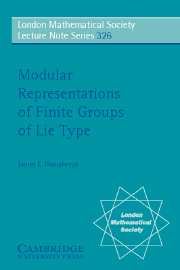Book contents
- Frontmatter
- Contents
- Preface
- 1 Finite Groups of Lie Type
- 2 Simple Modules
- 3 Weyl Modules and Lusztig's Conjecture
- 4 Computation of Weight Multiplicities
- 5 Other Aspects of Simple Modules
- 6 Tensor Products
- 7 BN-Pairs and Induced Modules
- 8 Blocks
- 9 Projective Modules
- 10 Comparison with Frobenius Kernels
- 11 Cartan Invariants
- 12 Extensions of Simple Modules
- 13 Loewy Series
- 14 Cohomology
- 15 Complexity and Support Varieties
- 16 Ordinary and Modular Representations
- 17 Deligne–Lusztig Characters
- 18 The Groups G2(q)
- 19 General and Special Linear Groups
- 20 Suzuki and Ree Groups
- Bibliography
- Frequently Used Symbols
- Index
7 - BN-Pairs and Induced Modules
Published online by Cambridge University Press: 23 November 2009
- Frontmatter
- Contents
- Preface
- 1 Finite Groups of Lie Type
- 2 Simple Modules
- 3 Weyl Modules and Lusztig's Conjecture
- 4 Computation of Weight Multiplicities
- 5 Other Aspects of Simple Modules
- 6 Tensor Products
- 7 BN-Pairs and Induced Modules
- 8 Blocks
- 9 Projective Modules
- 10 Comparison with Frobenius Kernels
- 11 Cartan Invariants
- 12 Extensions of Simple Modules
- 13 Loewy Series
- 14 Cohomology
- 15 Complexity and Support Varieties
- 16 Ordinary and Modular Representations
- 17 Deligne–Lusztig Characters
- 18 The Groups G2(q)
- 19 General and Special Linear Groups
- 20 Suzuki and Ree Groups
- Bibliography
- Frequently Used Symbols
- Index
Summary
Thus far we have looked at simple modules from the algebraic group viewpoint. In this chapter we digress briefly to survey the more intrinsic approach involving finite groups with a split BN-pair (1.7). Here there are several natural ways to realize the simple modules as quotients or submodules of explicitly constructed KG-modules.
Curtis and Richen work inside KG itself, finding a reasonable substitute for highest weights (7.1).
Induction of 1-dimensional B-modules to G provides an alternative “principal series” framework for the classification of simple modules, which can be characterized in terms of images of intertwining maps (7.2). The approach by Carter and Lusztig parallels in many respects the study of maps between cohomology groups of line bundles on the flag variety of G.
Further work by Sawada and others has clarified the nature of the indecomposable summands in the related module induced from the trivial character of the Sylow p-subgroup U (7.4).
From a more geometric viewpoint, Ronan and Smith have studied the 0th homology of the Tits complex (based on parabolic subgroups of G) relative to coefficient systems coming from the module theory of KG (7.5). Schmidt makes a further comparison between the top homology modules and the principal series modules (7.6).
While the techniques involved in these various constructions are concrete and self-contained, they do not as yet yield more detailed information or conjectures about the Brauer characters of simple modules.
- Type
- Chapter
- Information
- Modular Representations of Finite Groups of Lie Type , pp. 61 - 66Publisher: Cambridge University PressPrint publication year: 2005



